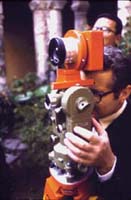

The camera is called a metric camera when it allows the reading of the data relating to the internal and external orientation of the beam of rays projecting the image intended to be fixed on the sensitive material. Internal orientation means the orientation of the beam of rays, projecting the image, with respect to the plane of the sensitive surface. It can be determined by:
- the distance of the projection center from the plane containing the sensitive emulsion (main distance);
- an orthogonal Cartesian reference system, originating from the main point. It should be remembered, in this regard, that the main point is the point of intersection, with the plane of the sensitive surface, of the perpendicular conducted by the center of projection (beam radius perpendicular to the plane itself or main beam).
For each metric chamber, the main distance is determined at the factory with the precision of one hundredth of a millimeter and is reported on the outside of the chamber or, inside, so as to appear on the frame. The orthogonal Cartesian reference system is generally identified by means of four references shown on the support framework of the sensitive material so as to be fixed, together with the image, on the frame during shooting. These references represent the ends of two segments that intersect at the main point, which (it should be specified) may not belong to the optical axis of the objective. The definition of the metric chamber, shown above, has a purely theoretical value since each manufacturer, when making it, must decide between a series of compromises, such as:
A) the flatness of the sensitive surface. This is a purely conventional choice, since the sensitive surface, within the limits allowed by the depth of focus, could still be deformed if it were possible to maintain the deformation unaltered up to the restitution phase. The format of the frame, in metric cameras, varies between 6.5x9 cm and 23x23 cm and, because the film, at the moment of shooting, is perfectly flat, a first choice that is imposed is that of the support (on which the sensitive emulsion) which may consist of:
- a rigid rectified sheet, for example made of glass, with all the drawbacks that this material presents (fragility, high weight, difficult maneuverability, high cost);
- transparent, flexible and inextensible material, which, in the most banal solution, can be pressed between two flat surfaces. In the case of large formats, it is possible to use a suction surface or an increase in pressure inside the chamber (at the moment of shooting), but these are systems that affect the cost and maneuverability of the chamber itself. Each choice, however simple, can pose secondary problems that should not be underestimated: for example, pressing the film between two surfaces, one of them, which for obvious reasons will be transparent to be crossed by the beam of rays projecting the image, will cause phenomena of refraction that will affect both the deformation of the image and the value of the main distance.
B) the goal. Given that a perfect objective exists only in theory and that the cost-quality diagram presents an asymptotic curve, a choice of the manufacturer consists in identifying a type of objective capable of offering sufficient guarantees of precision and not too high costs: to have a idea of the most common characteristics of the objectives used in photogrammetry, it is sufficient to take note of the distortion (which on average is less than 5 microns: the radial distortion is considered positive when the light beam, which hits the objective, is deflected with respect to the optical axis in so as to move the image point outwards), and of the resolving power, which is between 50 and 100 lines per mm. In order not to alter the internal orientation, the most logical solution would be to prevent any relative movement of the lens with respect to the sensitive surface: therefore variable decentralization, the interchangeability of the optics are excluded (when we talk about interchangeable optics we refer to the target-negative target block) and, in most cases, focusing which, when not fixed, is carried out on predetermined positions or by means of spacer rings. The exposure time can vary, on average, from 1 s to 1/500 s (in addition to pose B) and is regulated by a mechanically or electromagnetically controlled central shutter. The aperture can be varied with diaphragm (whose values are between f: 5.6 and f: 64) that can be used to adjust the depth of field. The shooting angle, corresponding to the longer side of the format, is generally between 60 ° and 80 °.
C) the depth of field. For a known law of optics, the images of all the points of an object